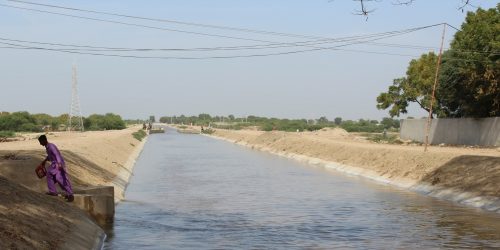People have started calling me the Chacha (uncle) who successfully harvested four different crops in a single year: cotton, corn, apple gourd, and wheat,” says the elderly man with pride. This year, his wheat crops have yielded exceptionally, and he has rotated crops to keep the soil healthy.
Mitho’s parcel of land sits at the tail end of the Nara Canal in a remote village in District Mirpurkhas in Sindh, Pakistan. Home to more than 50 million people, the province faces a harsh climate. Access to water is a challenge.
For Mitho and many other local farmers, the successful upgrade of the canal’s irrigation system through the World Bank’s Pakistan Sindh Water Sector Improvement Project (WSIP) has been a game changer.
With the underlying objective of improving canal water distribution in Sindh, the project has finished upgrading infrastructure in seven main canals, 28 branch canals, 173 distributaries, and improving drainage infrastructure across 200,000 hectares of farmland.
As water has become more readily available, farming communities who had left are now settling back in the area. Crop yields have increased, and livestock is healthier. Farmers are also experimenting with new crops in the region.
I have been working on this project for more than three years. One of the biggest challenges is that of upstream-downstream inequity in Main Canals.
Ensuring equitable supply of irrigation water requires the consensus of all farmers along the canal, and the ability and willingness of relevant institutions to implement that consensus.
This Project applied both engineering and institutional approaches to address this challenge.
The infrastructure modernization ensured adequate hydraulic control at critical points in the canal system, while the social and institutional dimensions have fostered good collaboration between the farmers (managed by the Area Water Boards and Farmers’ Organizations), and engineers (managed by the Irrigation Department).
The Sindh Irrigation and Drainage Authority (SIDA) played a critical role as an intermediary between the two sets of actors.
Another priority is to modernize Sindh’s irrigation system, which was developed more than 80 years ago when the demand for water was less
Now greater needs for drinking water, agriculture, industries, and ecosystems have made it urgent to regulate water flows better.
To this end, the project is bringing best practices from around the world, and has suggested several water management models to the Government of Sindh.
The current legal framework, which is based on the Sindh Irrigation Act of 1879, is being updated to cover water resources management such as water quality and protection of wetlands.
I am very glad that the Government of Sindh has recognized these needs and has taken the initiative to develop its own Water Policy.
This policy can be a symbol of the Government’s commitment to better water resources management.
Despite difficulties imposed by the COVID-19 pandemic, the Government of Sindh recently conducted the first meeting of the Inter-departmental Steering Committee for the Sindh Water Policy, demonstrating its commitment to this process of transformation in water management.
The WSIP success story is now being recognized internationally. It has recently won the Award of Merit in Engineering News-Record’s (ENR) 8th annual Global Best Projects competition, after it was submitted by Mott MacDonald.
The World Bank remains committed to assisting the Government in this cause.
My colleagues and I are working on WSIP and will continue to work side by side with the farmers, engineers, and public servants of Sindh to ensure a water secure future for the Province and to help farmers like Mitho access precious water needed to grow healthy crops and create better lives for themselves and their families.







